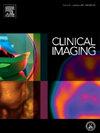Vessel-specific reliability of artificial intelligence-based coronary artery calcium scoring on non-ECG-gated chest CT: a comparative study with ECG-gated cardiac CT
IF 1.5
4区 医学
Q3 RADIOLOGY, NUCLEAR MEDICINE & MEDICAL IMAGING
引用次数: 0
Abstract
Purpose
To evaluate the performance of artificial intelligence (AI)-based coronary artery calcium scoring (CACS) on non-electrocardiogram (ECG)-gated chest CT, using manual quantification as the reference standard, while characterizing per-vessel reliability and clinical risk classification impacts.
Methods
Retrospective study of 290 patients (June 2023–2024) with paired non-ECG-gated chest CT and ECG-gated cardiac CT (median time was 2 days). AI-based CACS and manual CACS (CACS_man) were compared using intraclass correlation coefficient (ICC) and weighted Cohen's kappa (3,1). Error types, anatomical distributions, and CACS of the lesions of individual arteries or segments were assessed in accordance with the Society of Cardiovascular Computed Tomography (SCCT) guidelines.
Results
The total CACS of chest CT demonstrated excellent concordance with CACS_man (ICC = 0.87, 95 % CI 0.84–0.90). Non-ECG-gated chest showed a 7.5-fold increased risk misclassification rate compared to ECG-gated cardiac CT (41.4 % vs. 5.5 %), with 35.5 % overclassification and 5.9 % underclassification. Vessel-specific analysis revealed paradoxical reliability of the left anterior descending artery (LAD) due to stent misclassification in four cases (ICC = 0.93 on chest CT vs 0.82 on cardiac CT), while the right coronary artery (RCA) demonstrated suboptimal performance with ICCs ranging from 0.60 to 0.68. Chest CT exhibited higher false-positive (1.9 % vs 0.5 %) and false-negative rates (14.4 % vs 4.3 %). False positive mainly derived from image noise in proximal LAD/RCA (median CACS 5.97 vs 3.45) and anatomical error, while false negatives involved RCA microcalcifications (median CACS 2.64).
Conclusions
AI-based non-ECG-gated chest CT demonstrates utility for opportunistic screening but requires protocol optimization to address vessel-specific limitations and mitigate 41.4 % risk misclassification rates.
基于人工智能的非心电图门控胸部CT冠状动脉钙评分的血管特异性可靠性:与心电图门控心脏CT的比较研究
目的评价基于人工智能(AI)的冠状动脉钙化评分(CACS)在非心电图门控胸部CT上的表现,以人工量化为参考标准,同时表征每根血管的可靠性和临床风险分类的影响。方法回顾性研究290例(2023年6月- 2024年6月)行非心电图门控胸部CT和心电图门控心脏CT配对(中位时间为2天)的患者。采用类内相关系数(ICC)和加权Cohen’s kappa(3,1)对基于ai的CACS和手动CACS (CACS_man)进行比较。根据心血管计算机断层扫描学会(SCCT)指南评估单个动脉或节段病变的错误类型、解剖分布和CACS。结果胸部CT总CACS与CACS_man具有很好的一致性(ICC = 0.87, 95% CI 0.84 ~ 0.90)。与ecg门控的心脏CT相比,非ecg门控的胸部显示出7.5倍的风险误分类率(41.4%比5.5%),其中35.5%的过度分类和5.9%的未分类。血管特异性分析显示,在4例病例中,由于支架错误分类,左前降支(LAD)的可靠性存在矛盾(胸部CT ICC = 0.93,心脏CT ICC = 0.82),而右冠状动脉(RCA)表现出不理想的性能,ICC范围为0.60至0.68。胸部CT表现出较高的假阳性率(1.9%比0.5%)和假阴性率(14.4%比4.3%)。假阳性主要来自LAD/RCA近端图像噪声(中位CACS 5.97 vs 3.45)和解剖误差,假阴性主要涉及RCA微钙化(中位CACS 2.64)。结论:基于sai的非ecg门控胸部CT显示了机会性筛查的效用,但需要优化方案以解决血管特异性限制,并降低41.4%的风险误分类率。
本文章由计算机程序翻译,如有差异,请以英文原文为准。
求助全文
约1分钟内获得全文
求助全文
来源期刊

Clinical Imaging
医学-核医学
CiteScore
4.60
自引率
0.00%
发文量
265
审稿时长
35 days
期刊介绍:
The mission of Clinical Imaging is to publish, in a timely manner, the very best radiology research from the United States and around the world with special attention to the impact of medical imaging on patient care. The journal''s publications cover all imaging modalities, radiology issues related to patients, policy and practice improvements, and clinically-oriented imaging physics and informatics. The journal is a valuable resource for practicing radiologists, radiologists-in-training and other clinicians with an interest in imaging. Papers are carefully peer-reviewed and selected by our experienced subject editors who are leading experts spanning the range of imaging sub-specialties, which include:
-Body Imaging-
Breast Imaging-
Cardiothoracic Imaging-
Imaging Physics and Informatics-
Molecular Imaging and Nuclear Medicine-
Musculoskeletal and Emergency Imaging-
Neuroradiology-
Practice, Policy & Education-
Pediatric Imaging-
Vascular and Interventional Radiology
 求助内容:
求助内容: 应助结果提醒方式:
应助结果提醒方式:


